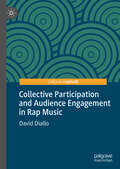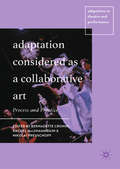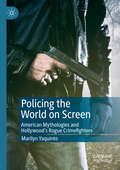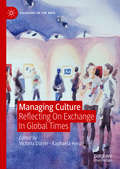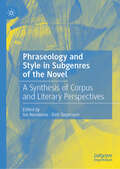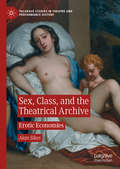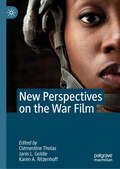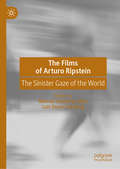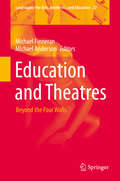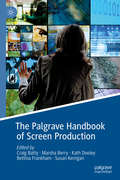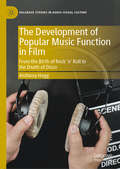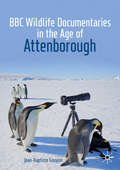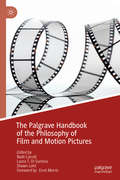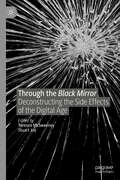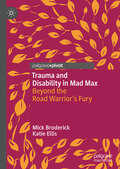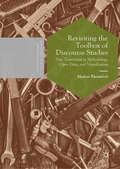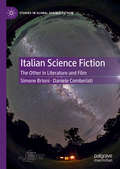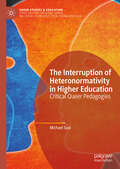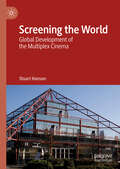- Table View
- List View
Audience Engagement in the Performing Arts: A Critical Analysis (New Directions in Cultural Policy Research)
by Ben WalmsleyThis book explores the concept of audience engagement from a number of complementary perspectives, including cultural value, arts marketing, co-creation and digital engagement. It offers a critical review of the existing literature on audience research and engagement, and provides an overview of established and emerging methodologies deployed to undertake research with audiences. The book focusses on the performing arts, but draws from a rich diversity of academic fields to make the case for a radically interdisciplinary approach to audience research. The book’s underlying thesis is that at the heart of audience research there is a mutual exchange of value wherein audiences ideally play the role of strategic partners in the mission fulfilment of arts organisations. Illustrating how audiences have traditionally been side-lined, homogenised and vilified, it contends that the future paradigm of audience studies should be based on an engagement model, wherein audiences take their rightful place as subjects rather than objects of empirical research.
Friends: A Reading of the Sitcom
by Simone Knox Kai Hanno SchwindThis book offers a long overdue, extensive study of one of the most beloved television shows: Friends. Why has this sitcom become the seminal success that it is? And how does it continue to engage viewers around the world a quarter century after its first broadcast? Featuring original interviews with key creative personnel (including co-creator Marta Kauffman and executive producer Kevin S. Bright), the book provides answers by identifying a strategy of intimacy that informs Friends’ use of humour, performance, style and set design. The authors provide fascinating analyses of some of the most well-remembered scenes—the one where Ross can’t get his leather pants back on, and Ross and Rachel’s break-up, to name just a couple—and reflect on how and why A-list guest performances sometimes fell short of the standards set by the ensemble cast. Also considered are the iconic look of Monica’s apartment as well as the programme’s much discussed politics of representation and the critical backlash it has received in recent years. An exploration of Joey, the infamous spin-off, and several attempts to adapt Friends’ successful formula across the globe, round out the discussion, with insights into mistranslated jokes and much more. For students, scholars, creative industry practitioners and fans alike, this is a compelling read that lets us glimpse behind the scenes of what has become a cultural phenomenon and semi-permanent fixture in many of our homes.
Collective Participation and Audience Engagement in Rap Music (Pop Music, Culture and Identity)
by David DialloWhy do rap MCs present their studio recorded lyrics as “live and direct”? Why do they so insistently define abilities or actions, theirs or someone else’s, against a pre-existing signifier? This book examines the compositional practice of rap lyricists and offers compelling answers to these questions. Through a 40 year-span analysis of the music, it argues that whether through the privileging of chanted call-and-response phrases or through rhetorical strategies meant to assist in getting one’s listening audience open, the focus of the first rap MCs on community building and successful performer-audience cooperation has remained prevalent on rap records with lyrics and production techniques encouraging the listener to become physically and emotionally involved in recorded performances. Relating rap’s rhetorical strategy of posing inferences through intertextuality to early call-and-response routines and crowd-controlling techniques, this study emphasizes how the dynamic and collective elements from the stage performances and battles of the formative years of rap have remained relevant in the creative process behind this music. It contends that the customary use of identifiable references and similes by rap lyricists works as a fluid interchange designed to keep the listener involved in the performance. Like call-and-response in live performances, it involves a dynamic form of communication and places MCs in a position where they activate the shared knowledge of their audience, making sure that they “know what they mean,” thus transforming their mediated lyrics into a collective and engaging performance.
Adaptation Considered as a Collaborative Art: Process and Practice (Adaptation in Theatre and Performance)
by Bernadette Cronin Rachel MagShamhráin Nikolai PreuschoffThis book examines the processes of adaptation across a number of intriguing case studies and media. Turning its attention from the 'what' to the 'how' of adaptation, it serves to re-situate the discourse of adaptation studies, moving away from the hypotheses that used to haunt it, such as fidelity, to questions of how texts, authors and other creative practitioners (always understood as a plurality) engage in dialogue with one another across cultures, media, languages, genders and time itself. With fifteen chapters across fields including fine art and theory, drama and theatre, and television, this interdisciplinary volume considers adaptation across the creative and performance arts, with a single focus on the collaborative.
The Films of Lars von Trier and Philosophy: Provocations and Engagements
by José A. Haro William H. KochThe films of Lars von Trier offer unique opportunities for thinking deeply about how Philosophy and Cinema speak to one another. The book addresses von Trier’s films in order of their release. The earlier chapters discuss his Golden Heart trilogy and USA: Land of Opportunities series by addressing issues of potential misogyny, ethical critique, and racial justice. The later chapters focus on his Depression Trilogy and address the undermining of gender binaries, the psychoanalytic meaning of the sacrifice of children and depression, and philosophical questions provoked by the depiction of the end of the world. Taken together, the volume explores the topics of Philosophical Psychology, Social Theory, Political Theory, Theories of the Self, Philosophy of Race, and Feminist Thought, and opens a conversation about von Trier’s important work.
Policing the World on Screen: American Mythologies and Hollywood's Rogue Crimefighters
by Marilyn YaquintoThis book analyzes Hollywood storytelling that features an American crimefighter—whether cop, detective, or agent—who must safeguard society and the nation by any means necessary. That often means going “rogue” and breaking the rules, even deploying ugly violence, but excused as self-defense or to serve the greater good. This ends-justifies-means approach dates back to gunfighters taming the western frontier to urban cowboy cops battling urban savagery—first personified by “Dirty” Harry Callahan—and later dispatched in global interventions to vanquish threats to national security. America as the world’s “policeman often means controlling the Other at home and abroad, which also extends American hegemony from the Cold War through the War on Terror. This book also examines pioneering portrayals by males of color and female crimefighters to embody such a social or national defender, which are frustrated by their existence as threats the white knight exists to defeat.
Managing Culture: Reflecting On Exchange In Global Times (Sociology of the Arts)
by Raphaela Henze Victoria DurrerThis book provides new insights into the relationship of the field of arts and cultural management and cultural rights on a global scale.Globalisation and internationalisation have facilitated new forms for exchange between individuals, professions, groups, localities and nations in arts and cultural management. Such exchanges take place through the devising, programming, exhibition, staging, marketing, and administration of project activities. They also take place through teaching and learning within higher education and cultural institutions, which are now internationalised practices themselves. With a focus on the fine, visual and performing arts, the book positions arts and cultural management educators and practitioners as active agents whose decisions, actions and interactions represent how we, as a society, approach, relate to, and understand ourselves and others. This consideration of education and practice as socialisation processes with global, political and social implications will be an invaluable resource to academics, practitioners and students engaging in arts and cultural management, cultural policy, cultural sociology, global and postcolonial studies.
Filmmaking as Research: Screening Memories
by Diane CharlesonThis book examines the challenges often experienced by film practitioners who find themselves researching within the academy, either as students or academics. In light of this the author presents her own journey from practitioner to researcher as a lens. Her practice- based research has been a quest to ”revision” memories, by creating filmic images that elicit memory and remembering. In so doing she has used a range of platforms: multi- screen video installation, still- framing the moving image and remixing found footage. Central to this research has been the importance of family storytelling and sharing, the relationship of the visual and memory, the agency of nostalgia and the role of aura, particularly evident in the re-appropriating of super 8 home movies into a variety of forms. Important to this is has been the relationship of the viewer and the viewed in particular the role of an immersive environment of viewing.
Transmediating the Whedonverse(s): Essays on Texts, Paratexts, and Metatexts
by Juliette C. Kitchens Julie L. HawkThis book explores the transmedial nature of the storyworlds created by and/or affiliated with television auteur, writer, and filmmaker, Joss Whedon. As such, the book addresses the ways in which Whedon’s storyworlds, or ‘verses, employ transmedia, both intrinsically as texts and extrinsically as these texts are consumed and, in some cases, reworked, by audiences. This collection walks readers through fan and scholar-fan engagement, intrinsic textual transmediality, and Whedon’s lasting influence on televisual and transmedia texts. In closing, the editors argue for the need to continue research into how the Whedonverse(s) lend themselves to transmedial study, engage audiences in ways that take advantage of multiple media, and encourage textual internalization of these engagements within audiences.
The Palgrave Handbook of the History of Women on Stage
by Jan Sewell Clare SmoutThis book brings together nearly 40 academics and theatre practitioners to chronicle and celebrate the courage, determination and achievements of women on stage across the ages and around the globe. The collection stretches from ancient Greece to present-day Australasia via the United States, Soviet Russia, Europe, India, South Africa and Japan, offering a series of analytical snapshots of women performers, their work and the conditions in which they produced it. Individual chapters provide in-depth consideration of specific moments in time and geography while the volume as a whole and its juxtapositions stimulate consideration of the bigger picture, underlining the challenges women have faced across cultures in establishing themselves as performers and the range of ways in which they gained access to the stage. Organised chronologically, the volume looks not just to the past but the future: it challenges the very notions of ‘history’, ‘stage’ and even the definition of ‘women’ itself.
Phraseology and Style in Subgenres of the Novel: A Synthesis of Corpus and Literary Perspectives
by Iva Novakova Dirk SiepmannThis edited book represents the first cohesive attempt to describe the literary genres of late-twentieth-century fiction in terms of lexico-grammatical patterns. Drawing on the PhraseoRom international project on the phraseology of contemporary novels, the contributed chapters combine literary studies with corpus linguistics to analyse fantasy, romance, crime, historical and science fiction in French and English. The authors offer new insights into long-standing debates on genre distinction and the hybridization of genres by deploying a new, interdisciplinary methodology. Sitting at the intersection of literature and linguistics, with a firm grounding in the digital humanities, this book will be of particular relevance to literary scholars, corpus stylists, contrastivists and lexicologists, as well as general readers with an interest in twentieth-century genre fiction.
Sex, Class, and the Theatrical Archive: Erotic Economies (Palgrave Studies in Theatre and Performance History)
by Alan SikesIn Sex, Class and the Theatrical Archive: Erotic Economies, Alan Sikes explores the intersection of struggles over sex and class identities in politicized performances during key revolutionary moments in modern European history. The book includes discussions of sodomitical closet dramas from the decades surrounding the English Glorious Revolution of 1688; the performances of 'Tribades and Amazons', public women of the French Revolution; the 'homophilic elitism' in the early plays of Brecht and Hasenclever from the years just before and after the German Revolution that marked the founding of the short-lived Weimar Republic; and the utopian conception of a Soviet 'New Woman' set to take the stage after the Russian Revolution of 1917. Throughout, Sikes invokes the differences between past and present politicized performances in order to cast our own political imaginings into sharper and more critical relief.
New Perspectives on the War Film
by Clémentine Tholas Janis L. Goldie Karen A. RitzenhoffNew Perspectives on the War Film addresses the gap in the representation of many forgotten faces of war in mainstream movies and global mass media. The authors concentrate on the untold narratives of those who fought in combat and were affected by its brutal consequences. Chapters discuss the historically under-represented stories of individuals including women, African-American and Indigenous Soldiers. Issues of homosexuality and gender relations in the military, colonial subjects and child soldiers, as well as the changing nature of war via terrorism and bioterrorism are closely analyzed. The contributors demonstrate how these viewpoints have been consistently ignored in mainstream, blockbuster war sagas and strive to re-integrate these lost perspectives into current and future narratives.
The Films of Arturo Ripstein: The Sinister Gaze of the World
by Manuel Gutiérrez Silva Luis Duno GottbergThis book gathers eleven scholarly contributions dedicated to the work of Mexican director Arturo Ripstein. The collection, the first of its kind, constitutes a sustained critical engagement with the twenty-nine films made by this highly acclaimed yet under-studied filmmaker. The eleven essays included come from scholars whose work stands at the intersection of the fields of Latin American and Mexican Film Studies, Gender and Queer Studies, Cultural Studies, History and Literary studies. Ripstein’s films, often scripted by his long-time collaborator, Paz Alicia Garciadiego, represent an unprecedented achievement in Mexican and Latin American film. Unlike many of his contemporaries, Ripstein has successfully maintained a prolific output unmatched by any director in the region. Though several book-length studies have been published in Spanish, French, German, and Greek, to date no analogue exists in English. This volume provides a much-needed contribution to the field.
Education and Theatres: Beyond the Four Walls (Landscapes: the Arts, Aesthetics, and Education #27)
by Michael Anderson Michael FinneranThis volume is the first book to map a broad range of practices and critically examine the impact of education and outreach programmes in theatres and theatre companies around the globe.This innovative volume looks specifically at the manner in which theatres and theatre companies engage in educational, outreach and community work. An array of global case studies examines a wide range of existing and innovative practices, and scrutinises how this work achieves successful results and delivers impact and outcome on investment.The editors set the scene briefly in terms of the history of education in theatre organisations, and then move on to chart some of the difficulties and challenges associated with this work, as well as looking into the conceptual issues that need to be interrogated so that we may understand the impact of outreach and education work on the communities and audiences it aims to reach. A range of theatre practitioners and academics describe their work, its background, and what the authors understand to be successful outcomes for both the participants and the theatres. Finally, the book offers suggestions for both practitioners and researchers regarding further development in this work.
The Palgrave Handbook of Screen Production
by Craig Batty Marsha Berry Susan Kerrigan Kath Dooley Bettina FrankhamThis handbook is an essential creative, critical and practical guide for students and educators of screen production internationally. It covers all aspects of screen production—from conceptualizing ideas and developing them, to realizing and then distributing them—across all forms and formats, including fiction and non-fiction for cinema, television, gallery spaces and the web. With chapters by practitioners, scholars and educators from around the world, the book provides a comprehensive collection of approaches for those studying and teaching the development and production of screen content. With college and university students in mind, the volume purposely combines theory and practice to offer a critically informed and intellectually rich guide to screen production, shaped by the needs of those working in education environments where ‘doing’ and ‘thinking’ must co-exist. The Palgrave Handbook of Screen Production fills an important gap in creative-critical knowledge of screen production, while also providing practical tools and approaches for future practitioners.
The Development of Popular Music Function in Film: From the Birth of Rock ‘n’ Roll to the Death of Disco (Palgrave Studies in Audio-Visual Culture)
by Anthony HoggThis book offers a unique examination of the development of popular music function in film. It assesses the contribution of popular music to the interpretation of the most significant films, covering the period from rock ‘n’ roll’s initial introduction at the opening of Blackboard Jungle, to the backlash against disco, which followed soon after the release of Saturday Night Fever. By dividing this period into five phases—The Classical American Musical Phase, The British Invasion Phase, The New Hollywood Alienation Phase, The Disco Phase and The Post-Disco Conservative Phase—the book pinpoints key moments at which individual developments occurred and lays out a path of expansion in popular music function. Each chapter offers close analyses of this period’s most innovative films; examines the cultural, historical, technical and industrial factors peculiar to each phase and considers the influence of these upon the specific timing of functional advances.
BBC Wildlife Documentaries in the Age of Attenborough (Palgrave Studies in Science and Popular Culture)
by Jean-Baptiste GouyonThis book explores the history of wildlife television in post-war Britain. It revolves around the role of David Attenborough, whose career as a broadcaster and natural history filmmaker has shaped British wildlife television. The book discusses aspects of Attenborough’s professional biography and also explores elements of the institutional history of the BBC—from the early 1960s, when it was at its most powerful, to the 2000s, when its future is uncertain. It focuses primarily on the wildlife ‘making-of’ documentary genre, which is used to trace how television progressively became a participant in the production of knowledge about nature. With the inclusion of analysis of television programmes, first-hand accounts, BBC archival material and, most notably, interviews with David Attenborough, this volume follows the development of the professional culture of wildlife broadcasting as it has been portrayed in public. It will be of interest to wildlife television amateurs, historians of British television and students in science communication.
The Palgrave Handbook of the Philosophy of Film and Motion Pictures
by Noël Carroll Laura T. Di Summa Shawn LohtThis handbook brings together essays in the philosophy of film and motion pictures from authorities across the spectrum. It boasts contributions from philosophers and film theorists alike, with many essays employing pluralist approaches to this interdisciplinary subject. Core areas treated include film ontology, film structure, psychology, authorship, narrative, and viewer emotion. Emerging areas of interest, including virtual reality, video games, and nonfictional and autobiographical film also have dedicated chapters. Other areas of focus include the film medium’s intersection with contemporary social issues, film’s kinship to other art forms, and the influence of historically seminal schools of thought in the philosophy of film. Of emphasis in many of the essays is the relationship and overlap of analytic and continental perspectives in this subject.
Through the Black Mirror: Deconstructing the Side Effects of the Digital Age
by Terence McSweeney Stuart JoyThis edited collection charts the first four seasons of Black Mirror and beyond, providing a rich social, historical and political context for the show. Across the diverse tapestry of its episodes, Black Mirror has both dramatized and deconstructed the shifting cultural and technological coordinates of the era like no other. With each of the nineteen chapters focussing on a single episode of the series, this book provides an in-depth analysis into how the show interrogates our contemporary desires and anxieties, while simultaneously encouraging audiences to contemplate the moral issues raised by each episode. What if we could record and replay our most intimate memories? How far should we go to protect our children? Would we choose to live forever? What does it mean to be human? These are just some of the questions posed by Black Mirror, and in turn, by this volume. Written by some of the foremost scholars in the field of contemporary film and television studies, Through the Black Mirror explores how Black Mirror has become a cultural barometer of the new millennial decades and questions what its embedded anxieties might tell us.
Trauma and Disability in Mad Max: Beyond the Road Warrior’s Fury
by Mick Broderick Katie EllisThis book explores the inter-relationship of disability and trauma in the Mad Max films (1979-2015). George Miller’s long-running series is replete with narratives and imagery of trauma, both physical and emotional, along with major and minor characters who are prominently disabled. The Mad Max movies foreground representations of the body – in devastating injury and its lasting effects – and in the broader social and historical contexts of trauma, disability, gender and myth.Over the franchise’s four-decade span significant social and cultural change has occurred globally. Many of the images of disability and trauma central to Max’s post-apocalyptic wasteland can be seen to represent these societal shifts, incorporating both decline and rejuvenation. These shifts include concerns with social, economic and political disintegration under late capitalism, projections of survival after nuclear war, and the impact of anthropogenic climate change.Drawing on screen production processes, textual analysis and reception studies this book interrogates the role of these representations of disability, trauma, gender and myth to offer an in-depth cultural analysis of the social critiques evident within the fantasies of Mad Max.
Revisiting the Toolbox of Discourse Studies: New Trajectories in Methodology, Open Data, and Visualization (Postdisciplinary Studies in Discourse)
by Markus RheindorfThis book revisits discourse analytic practice, analyzing the idea that the field has access to, provides, or even constitutes a ‘toolbox’ of methods. The precise characteristics of this toolbox have remained largely un-theorized, and the author discusses the different sets of tools and their combinations, particularly those that cut across traditional divides, such as those between disciplines or between quantitative and qualitative methods. The author emphasizes the potential value of integrating methods in terms of triangulation and its specific benefits, arguing that current trends in Open Science require Discourse Studies to re-examine its methodological scope and choices, and move beyond token acknowledgements of ‘eclecticism’. In-depth case studies supplement the methodological discussion and demonstrate the challenges and benefits of triangulation. This book will be a valuable resource for students and scholars in Discourse Studies, particularly those with an interest in combining methods and working across disciplines.
Italian Science Fiction: The Other in Literature and Film (Studies in Global Science Fiction)
by Simone Brioni Daniele ComberiatiThis book explores Italian science fiction from 1861, the year of Italy’s unification, to the present day, focusing on how this genre helped shape notions of Otherness and Normalness. In particular, Italian Science Fiction draws upon critical race studies, postcolonial theory, and feminist studies to explore how migration, colonialism, multiculturalism, and racism have been represented in genre film and literature. Topics include the role of science fiction in constructing a national identity; the representation and self-representation of “alien” immigrants in Italy; the creation of internal “Others,” such as southerners and Roma; the intersections of gender and race discrimination; and Italian science fiction’s transnational dialogue with foreign science fiction. This book reveals that though it is arguably a minor genre in Italy, science fiction offers an innovative interpretive angle for rethinking Italian history and imagining future change in Italian society.
The Interruption of Heteronormativity in Higher Education: Critical Queer Pedagogies (Queer Studies and Education)
by Michael SealThis book examines how heteronormativity in higher education can be interrupted and resisted. Located within the theoretical framework of queer and critical pedagogy and based on extensive empirical research, the author explores the dynamics of heteronormativity and its interruption on professional courses in a range of higher education institutions. Reactions to attempt to interrupt it were nuanced: while strategies of contested engagement, avoidance and retreat were expressed, heterosexualities were largely un-examined and un-articulated. ‘Coming out’ needs to be a pedagogical act, carried out concurrently with the interruptions of other social constructions and binary oppositions. The author calls for co-created and co-held meta-reflexive and liminal spaces that emphasise inter-subjectivity, encounters, and working in the moment. These spaces must de-construct and reconstruct pedagogical power and knowledge to promote collective intersubjective consciousnesses, and widen the vision of the reflective practitioner to that of the pedagogical practitioner. This pioneering book is a call to action to all those concerned with interrupting and problematising presumed binary categories of sexuality within the heterosexual matrix.
Screening the World: Global Development of the Multiplex Cinema
by Stuart HansonThis book charts the development of the multiplex cinema as the pre-eminent form of film exhibition across the world. Going from its origins in the USA in the 1960s to its expansion overseas from the mid-1980s across Europe, Australia and other parts of Asia-Pacific, the book considers the emergence of a series of initially regional, then national and then international exhibition circuits. However, more than a consideration of US overseas expansion on the part of companies, this book examines the hegemony of the multiplex as a cultural and business form, arguing for its significance as a phenomenon that has transcended national and global boundaries and which has become the predominant venue for film viewing. Implicit in this analysis is a recognition of the domination of US media multi-nationals and Hollywood cinema, and the development of the multiplex cinema as symbolic of the extension and maintenance of the USA’s cultural and economic power. With case studies ranging from European countries such as Belgium, France, Germany and The Netherlands, to Pacific-Asian countries such as Australia, China, Japan and South Korea, this book is the first to explore the development of multiplexes on a global scale.


